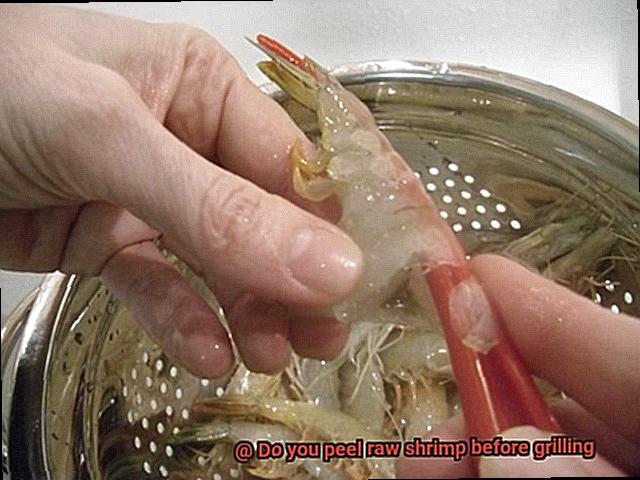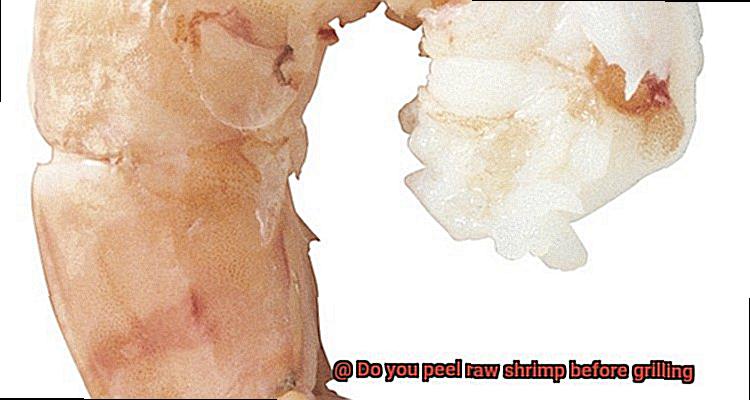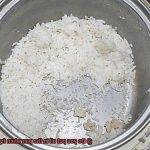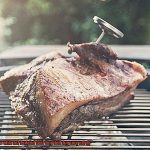The sizzling summer heat is here, and our taste buds are itching for that smoky aroma and mouthwatering flavors of grilled delicacies. And when it comes to seafood, nothing steals the show like succulent shrimp – its delicate texture and irresistible taste make hearts skip a beat. But before we dive into the grilling game, let’s address the burning question – should we peel these little crustaceans before tossing them on the flames?
In the world of seafood aficionados, the debate on whether to peel raw shrimp before grilling is as fiery as the grill itself. Some say peeling helps the marinade seep into every nook and cranny, while others swear by grilling with shells intact to lock in those juicy flavors and create an explosion of taste.
Now, let’s find a middle ground that caters to all palate preferences. By tailoring your preparation method, you can achieve a perfect balance between convenience and flavor, ensuring your grilled shrimp experience is nothing short of spectacular.
To embark on this gastronomic journey, start by choosing fresh and high-quality raw shrimp. Make sure they’re properly deveined to avoid any unwelcome surprises during your dining escapade. Now, let’s explore two tempting roads ahead – peeling or not peeling?
Contents
Option 1: The Unpeeled Marvel
Grilling shrimp with their shells on is like unwrapping a present at the table – it reveals an elegant and tasty surprise. The shells act as a natural protective layer against searing heat, sealing in delicate flavors while promoting even cooking. Here’s a pro tip – before grilling, make a shallow slit along the back of each shrimp to help marinade penetrate the flesh. This method adds a slight charred intensity to your dish, allowing flavors to mingle and dance on your taste buds.
Option 2: The Succulent Naked Approach
For those seeking shrimp that’s ready to devour with minimal effort, peeling before grilling can be the way to go. Removing the shells saves diners the hassle of peeling after cooking and allows for easier seasoning penetration. Simply marinate the peeled shrimp before grilling to infuse them with a delightful blend of flavors, ensuring every bite is a succulent mouthful. Pro tip: reserve a portion of the marinade to drizzle over the cooked shrimp for an extra burst of flavor.
What is Grilling Shrimp?
Grilling shrimp is a culinary technique that involves cooking raw shrimp directly on a grill or barbecue. The process creates an enticing combination of smoky flavor and a perfectly charred texture, resulting in succulent shrimp that are bursting with taste.
When grilling shrimp, it is crucial to ensure the right temperature and cooking time to achieve the desired outcome. Shrimp cook quickly, typically taking only a few minutes per side. It’s important to keep a watchful eye on them to prevent overcooking and ending up with a rubbery texture.
The advantages of grilling shrimp are numerous. Firstly, it is a speedy cooking method, making it ideal for those seeking a delicious meal in no time. Grilled shrimp can be served in various ways, from appetizers to main courses, adding versatility to your culinary repertoire.
To prepare shrimp for grilling, there are different approaches depending on personal preference. Some prefer to peel the shrimp before grilling while others opt to leave the shells intact. Both methods have their merits and yield mouthwatering results.
Grilling peeled shrimp offers convenience as the shells have been removed, facilitating easy consumption. Furthermore, peeled shrimp tend to cook faster since there is no protective layer. This method is perfect for those looking for quick and hassle-free cooking.
On the other hand, grilling shrimp with their shells intact has its own set of advantages. The shells act as a protective barrier, preventing the shrimp from drying out and locking in moisture during the cooking process. Additionally, grilling shrimp with the shell on imparts a slightly smoky flavor to the flesh, enhancing the overall taste experience.
While both methods produce delectable grilled shrimp, they also come with their drawbacks. Grilling peeled shrimp can result in dryness if not properly marinated beforehand. On the contrary, leaving the shells on can make it challenging to effectively marinate the shrimp, as flavors might not penetrate through the shell as well.
Pros and Cons of Grilling Shrimp with Shell On
Grilling shrimp with the shell on has its advantages and disadvantages. Let’s delve into the pros and cons of this cooking method.
Starting with the pros, grilling shrimp with the shell on helps to retain moisture. The shell acts as a protective barrier, ensuring that the flesh remains juicy and tender throughout the cooking process. This is crucial because shrimp can easily dry out and become tough if overcooked. By keeping the shells intact, you’re ensuring a succulent and delicious result.

Another advantage is the added flavor. As the shrimp cook, the shell imparts a delightful smoky and charred taste that elevates the overall flavor profile of the dish. It’s like a natural seasoning that enhances your grilling experience and makes every bite more enjoyable.
Grilling shrimp with the shell on also makes them easier to handle. The shell provides a convenient natural handle, allowing you to flip the shrimp without fear of them falling apart or sticking to the grill grates. This is particularly useful when grilling a large batch or if you’re a novice griller looking for some extra assistance.
Moreover, leaving the shells on prevents the shrimp from sticking to the grill. The shell acts as a barrier between the flesh and the grill grates, reducing the chances of sticking and tearing. This means you’ll have perfectly grilled shrimp without any hassle or mess.
Visually, grilling shrimp with the shell on adds an appealing element to your dish. The vibrant colors of the shells create an eye-catching presentation that makes your meal more enticing and appetizing.
However, there are some downsides to consider. One disadvantage is that seasoning the shrimp evenly can be more challenging when they have their shells on. The flavors may not penetrate through the shell, resulting in a less flavorful outcome. If you prefer your shrimp well-seasoned, it might be better to peel them before grilling.
Eating grilled shrimp with the shell on can also be a messy experience. Removing the shells while eating can be cumbersome and may leave your fingers and plates covered in sauce and remnants. Some people prefer to peel their shrimp before grilling because it’s easier to eat without the shells.
Lastly, peeling shrimp before grilling allows for better flavor absorption. The marinade or seasoning can penetrate the flesh more effectively, resulting in a more flavorful and well-seasoned dish.
Pros and Cons of Peeling Shrimp Before Grilling
Grilling shrimp with the shell on has its advantages. The shell acts as a protective barrier, keeping the shrimp moist and juicy during grilling. It helps to retain the natural flavors of the shrimp and adds a smoky note to the dish. Additionally, grilling shrimp with the shell on makes them easier to handle. The shell provides a convenient handle for flipping the shrimp, preventing them from falling through the grill grates. It also helps to keep the shrimp intact while cooking.
However, there are some challenges associated with grilling shrimp with the shell on. One issue is uneven seasoning. The seasoning or marinade applied to the outside of the shell may not fully penetrate the shrimp, resulting in uneven flavor distribution. This can lead to bites that are overly seasoned or lacking in flavor.
Another drawback of grilling shrimp with the shell on is the messy aftermath. Eating shrimp with the shell on can be messy and require extra effort to remove the shell while eating. This can take away from the enjoyment of the meal and result in a less satisfying dining experience.
On the other hand, peeling shrimp before grilling can have its benefits. One advantage is that it allows for better flavor infusion. When the shrimp is peeled, the marinade or seasoning can penetrate the flesh more effectively, resulting in a more flavorful and delicious outcome. The absence of the shell also allows for better absorption of any sauces or glazes applied during grilling.
Additionally, peeling shrimp before grilling can save time and effort. Removing the shell can be a time-consuming task, especially if you have a large batch of shrimp to prepare. By peeling them beforehand, you can streamline the cooking process and focus on grilling rather than shell removal.
However, there are some potential drawbacks to peeling shrimp before grilling. One of them is that the shrimp may become drier and lose moisture during grilling without the protective shell. The shell acts as a natural barrier, keeping the moisture within the shrimp while it cooks. Without it, the shrimp may be more prone to drying out and becoming overcooked.
Another disadvantage is that peeled shrimp can be more delicate and prone to sticking on the grill. The shell provides a certain level of protection against direct heat, preventing the shrimp from sticking to the grill grates. Without it, there is a higher chance of the shrimp sticking and potentially falling apart when flipping or removing them from the grill.
Lastly, peeling shrimp before grilling may result in a loss of some flavor elements. The shells of shrimp contain flavorful compounds that can enhance the taste of the dish. By removing the shells, you might miss out on these unique flavors that contribute to the overall enjoyment of grilled shrimp.
Tips for Grilling Shrimp with the Shell On
When it comes to grilling shrimp, one of the biggest debates among seafood lovers is whether to peel the shrimp before cooking or leave the shell on. Both methods have their advantages and can result in delicious grilled shrimp, but it ultimately boils down to personal preference.
Grilling shrimp with the shell on is a popular choice for many grill masters. One of the main reasons is that the shell acts as a protective barrier, preventing the delicate shrimp meat from drying out during the grilling process. The shell helps to retain moisture and adds a smoky flavor to the dish as it chars on the grill. Additionally, leaving the shell on can make for an impressive presentation, especially if you choose to leave the tail intact. It adds an aesthetic appeal to your grilled shrimp that is hard to resist.
However, if you prefer your shrimp without the hassle of shells, peeling them before grilling may be more up your alley. When you peel the shrimp, it eliminates the need to remove the shells while enjoying your dish. This can make eating grilled shrimp much easier and less messy, especially if you plan on serving them at a social gathering or picnic. Some people also find that grilling peeled shrimp results in a more tender and succulent texture, as they are directly exposed to the heat of the grill.
Regardless of whether you choose to grill shrimp with the shell on or peel it off, there are a few important steps to take before firing up your grill. It is crucial to clean and devein the shrimp before grilling, regardless of your chosen method. Cleaning involves rinsing the shrimp under cold water and removing any visible dirt or debris. To devein the shrimp, make a shallow cut along the back using a sharp knife and remove the dark vein running through the center. This step ensures that your grilled shrimp will be free from grit and impurities.
Tips for Peeling and Marinating Shrimp Before Grilling
Grilling shrimp is a delicious way to enjoy this succulent seafood, but there is some debate about whether to peel the shrimp before grilling or leave the shells on. Let’s explore both options to help you make an informed decision.
Grilling with the shell on has its advantages. Some people argue that leaving the shells on helps to retain moisture and flavor. The shell acts as a protective barrier, preventing the shrimp from sticking to the grill grates. It also adds a slightly smoky flavor to the shrimp as it grills. Plus, leaving the tail intact can add a touch of elegance to your dish.
On the other hand, peeling the shrimp before grilling has its own benefits. When you remove the shell, it allows for easier eating and eliminates the need to remove it while enjoying your dish. Some individuals find that grilling peeled shrimp results in a more tender and succulent texture. Plus, by peeling the shrimp, you have the opportunity to devein them, removing any grit or impurities for a cleaner taste.
Ultimately, the decision of whether or not to peel raw shrimp before grilling depends on personal preference and desired outcome. If you prefer convenience and ease of eating, peeling is the way to go. If you enjoy the added flavor and protection of the shell, then grilling with the shells on might be your preference.
Preparing Shrimp for Grilling
Whichever option you choose, it’s important to properly prepare the shrimp before grilling. Start by removing the heads if desired and deveining them if you decide to peel them. This will ensure that your shrimp are clean and ready for marinating.
To peel shrimp, hold onto the body with one hand and gently twist off the head with the other. Some people prefer to leave the tail intact for presentation purposes, while others prefer to remove it as well. Next, make a shallow incision along the back of the shrimp using a sharp knife or kitchen shears, then carefully remove the shell by peeling it away from the body. Be sure to remove the black vein running along the back, as it can give the shrimp a gritty texture and unpleasant taste.
Marinating Shrimp for Optimal Flavor
Once the shrimp are peeled, they can be marinated to enhance their flavor. Marinating helps to infuse the shrimp with different seasonings and can also tenderize the meat.
When marinating shrimp, it is important to use a combination of acidic ingredients (such as citrus juice or vinegar) and oil-based ingredients (such as olive oil) to help break down the proteins and add moisture to the meat. Popular marinade ingredients for shrimp include lemon or lime juice, garlic, herbs (such as parsley or cilantro), soy sauce, honey, and various spices (such as paprika, cayenne pepper, or cumin).
To marinate shrimp, place them in a shallow dish or resealable plastic bag and pour the marinade over them. Make sure all the shrimp are coated evenly and allow them to marinate in the refrigerator for at least 30 minutes (or up to 2 hours) before grilling.
It is important not to marinate shrimp for too long, as the acid in the marinade can start to “cook” the meat, resulting in a mushy texture. Additionally, if using a marinade that contains citrus juice, avoid prolonged exposure to avoid a “ceviche-like” texture.
Grilling Marinated Shrimp
Before grilling the marinated shrimp, make sure to preheat the grill to medium-high heat and lightly oil the grates to prevent sticking.
Different Cooking Methods for Grilled Shrimp
Grilled shrimp can be prepared using various cooking methods, each offering a unique flavor and texture to the dish. Let’s explore these methods:
- Skewers: Thread peeled or unpeeled shrimp onto skewers and place them directly on the grill. The heat evenly cooks the shrimp, resulting in a slightly charred and smoky flavor.
- Foil Packets: Wrap the shrimp in aluminum foil with seasonings, herbs, and a touch of oil. The foil packet helps retain moisture and infuse the shrimp with flavors, resulting in a tender and flavorful dish.
- Cast Iron Skillet: Heat a skillet on the grill and add the shrimp directly to it. The skillet creates a seared crust while locking in moisture, resulting in juicy and succulent shrimp.
- Grill Mat or Basket: For a healthier option, grill shrimp on a mat or basket. This prevents the shrimp from falling through the grates while still allowing even cooking. It also reduces the need for oil, making it a healthier choice.
- Directly on Grates: For a charred and crispy exterior, grill shrimp directly on the grates. Keep a close eye to prevent sticking or overcooking. This method maintains a tender and juicy interior.
Remember to properly season the shrimp before grilling. Marinate them in olive oil, lemon juice, garlic, herbs, and spices for at least 30 minutes before grilling. This enhances the flavor and prevents drying out during cooking.
How to Serve and Enjoy Grilled Shrimp
When it comes to serving grilled shrimp, presentation is key. You want to make sure that the dish looks appetizing and inviting. One simple and elegant way to serve grilled shrimp is on a platter with fresh lemon wedges and a sprinkle of chopped parsley or cilantro for added freshness and color. This creates a visually appealing display that immediately whets the appetite. Another option is to serve grilled shrimp skewers, which not only look great but also provide convenience for guests to easily pick up and enjoy their shrimp.
Accompaniments:
The right accompaniments can enhance the flavors of grilled shrimp. A classic choice is to serve it with a side of cocktail sauce, which provides a tangy and slightly spicy kick that complements the natural sweetness of the shrimp. Alternatively, you can opt for a garlic butter dipping sauce, which adds richness and depth to each bite. These sauces add an extra layer of flavor that takes the grilled shrimp to another level.
Pairings:
Grilled shrimp pairs well with various side dishes. One popular choice is to serve it alongside a fresh green salad, which provides a refreshing contrast to the smoky flavors of the shrimp. Another option is to pair it with grilled vegetables such as zucchini, bell peppers, or asparagus, which adds a deliciously charred element to the meal. These side dishes not only complement the flavors of the grilled shrimp but also add variety and balance to the overall meal.
Savoring Each Bite:
When it comes to enjoying grilled shrimp, take your time to savor each bite. The smoky char from the grill, combined with the tender and succulent flesh of the shrimp, creates a delightful combination that deserves to be savored. Appreciate the flavors and textures of the perfectly grilled shrimp, and let them linger on your palate. By fully immersing yourself in the experience, you can truly enjoy and appreciate the deliciousness of grilled shrimp.
Peeling or Not:
Whether you choose to peel the shrimp before grilling or leave them unpeeled is a matter of personal preference. Some people prefer the convenience of peeled shrimp, as it eliminates the need to remove the shells while eating. On the other hand, leaving the shells on can help to retain moisture and flavor during the grilling process. Regardless of your choice, make sure to provide a means for guests to discard the shells, such as a small bowl or plate nearby.
Nutritional Benefits of Eating Grilled Shrimp
When it comes to nutrition, grilled shrimp offers a range of benefits that make it a wonderful addition to any diet. Let’s dive into the nutritional advantages of this delicious seafood:
- Low in Calories and Fat: Grilled shrimp is a fantastic option for those watching their weight or trying to maintain a balanced diet. With only about 84 calories per 3-ounce serving, it’s a guilt-free protein choice. Additionally, it contains minimal amounts of fat, with less than 1 gram per serving.
- Excellent Source of Lean Protein: Shrimp is packed with lean protein, containing all nine essential amino acids that the body needs for optimal health and muscle growth. A 3-ounce serving provides approximately 18 grams of protein, making it an excellent choice for athletes and individuals looking to build or maintain muscle mass.
- Rich in Omega-3 Fatty Acids: Shrimp is an abundant source of omega-3 fatty acids, which are crucial for heart health. These healthy fats have been linked to a reduced risk of chronic diseases such as heart disease and inflammation. Including grilled shrimp in your diet can help support cardiovascular well-being.
- Good Source of Vitamins and Minerals: Grilled shrimp is not only delicious but also packed with essential vitamins and minerals. It is particularly rich in vitamin B12, selenium, and zinc. Vitamin B12 aids in the production of red blood cells and supports the nervous system. Selenium and zinc are vital for immune function and cell growth.
- Provides Iodine for Thyroid Function: Shrimp is also an excellent source of iodine, a mineral that plays a crucial role in thyroid function and metabolism. Including grilled shrimp in your meals can help ensure you meet your recommended daily intake of iodine.
- Low in Carbs and Gluten-Free: If you’re following a low-carb or gluten-free diet, grilled shrimp is a fantastic choice. It is naturally low in carbohydrates and does not contain gluten, making it suitable for individuals with gluten intolerance or celiac disease.
- Versatile and Delicious: Grilled shrimp is a versatile ingredient that can be paired with various vegetables and whole grains to create a well-balanced meal. Whether tossed in a salad, skewered with colorful veggies, or served alongside quinoa, grilled shrimp adds a burst of flavor and nutrition to any dish.
Conclusion
In conclusion, when it comes to grilling raw shrimp, the decision of whether or not to peel them is a matter of personal preference.
Some people argue that leaving the shells on helps to retain moisture and flavor during the grilling process. On the other hand, peeling the shrimp before grilling allows for easier consumption and eliminates the need for messy shell removal at the dinner table.
So, go ahead and experiment with both methods to find out which one suits your palate and grilling style best.






